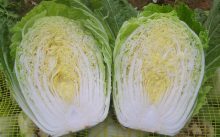Choose which flowers to plant in the fall in the country. Flower seeds for winter: autumn crops
At the end of October, sometimes even earlier, they finish active work on the plot. But already at the beginning of spring you want to see your garden blooming and beautiful. How to achieve this will tell the material of this article.
Late autumn, planting flower seeds. Not a problem, if you do an autumn planting for the first time, it is not difficult. In the fall, you can sow the seeds of various crops, while they will give excellent shoots in the spring. Such subwinter crops have a number of advantages: saving time in spring and early shoots.
Advantages of autumn planting flowers
In the early spring to enjoy the pretty shoots of flowers and their bright blooms, take care of this in advance. At first sight, it will seem to novice gardeners that autumn sowing of seeds is not the best way to grow strong and decent flower crops. But this is not true, the main advantage of the proposed method is hardening of the plant. Seeds that have spent 3–4 months in the ground, survived the cold winter months, produce truly resistant, strong and high-quality shoots. These plants will "breathe health", perfectly form the stem and have a deep root system. A powerful root is able to extract water from deep layers of soil, which will affect a smaller irrigation regime. In addition, the subwinter crops are less sensitive to possible frosts and other weather conditions.The obvious advantages of autumn planting include the lack of excitement in the spring about the temperature of the earth. You will no longer be tormented by the question, is the soil warm enough for planting your favorite flowers and transplanting? The development of seeds planted in the fall, begins according to the natural cycle, the young seedlings appear at the right moment, mother - nature takes care of this.
The third great advantage of this method is the elementary saving of your time and energy in the spring period, when there are many other works in the garden ahead, besides planting flowers. There is only one small nuance - the relatively low germination of seeds of annual flowers as compared with the seedling method of cultivation.
Autumn planting annuals
I think many spring in their areas found the sudden shoots of kosmei or marigold, which bloomed last summer. These flowers have multiplied by self-sowing, in principle, any flowers can do this. However, in the fall, sow only cold-resistant seeds of annual flowers, the sprouts of which will definitely not die from frost in early spring. All procedures for autumn sowing begin after the onset of cold weather. This is usually the period from the end of October to the beginning of November, at which time in many regions of Russia the upper soil layer was already frozen. It is necessary to sow in the frozen soil, otherwise in the event of an unexpected thaw, the seeds will germinate and then die.Prepare a site for sowing in advance. Plan a flower bed so that in the spring the seeds are not washed with melt water and there is no scorching sun. Dig the soil, fertilize, make small grooves in the form of grooves and leave the bed until frost.
At the right time, add seeds to the prepared bed and fill it with a mixture of either peat and sand, or humus with sand. For a successful "wintering" you can cover the soil with dry leaves. Watering autumn crops is not worth it. Given the low germination of seeds of autumn sowing, sow them somewhat thicker than with the usual planting in spring. When the plants “hatch” in the spring, they can be thinned out in the stage of two or three leaves, if they grow densely.
Annuals for planting under the winter
Most often on the shelves you can find such bags with seeds annual flowers as Adonis aestivalis, phlox, aster Chinese, Reseda fragrant, Dianthus chinensis, Mattioli bicornuate, godetsiya grandiflora, snapdragons, Papaver rhoeas, kosmeya, delphinium Ajax, chrysanthemum, marigold, alissum sea.There is a huge selection of annuals, and now, using the knowledge gained, feel free to start the autumn planting of flowers.
Autumn has already come into its own, the gardens have been filled with bright colors of the new season - asters, chrysanthemums and dahlias are burning with bright colors, the leaves turn yellow ... real cold weather is not far off, and with them the end of the next gardening season.
However, experienced gardeners know that autumn is a time of many worries and troubles necessary for preparation already for the next season. Among them - autumn crops.
Sub-winter planting of annual and perennial flowers implies planting already on frozen ground - in late October - early November, or even over snow - in December - January. However, preparing for the winter-sowing of flowers should begin now: prepare the soil, ridges and, of course, stock up on seeds.
If you have never sown before winter, the very thought of such a method of growing flowers can make you chill: why are they, gentle, throwing them directly into the snow? In fact, it is the subwinter seeding of many flowers that often gives the best results.
Pros and cons of podzimnyh crops
So, why do you need to sow flowers in the cold?Under natural habitat, flowers tend to multiply quite independently. After ripening, the seeds fall into the soil, spend the winter under the snow and begin to germinate with the first spring rays of the sun. That is, such sowing creates natural conditions for growth (of course, it is mainly about cold-resistant plants).
In this situation, the plants are hardened and grow stronger and more durable than when grown in greenhouse conditions. They are fully capable of resisting spring frosts, they are resistant to diseases and good growth. In addition, hardened plants develop a healthier and deeper root system, which allows them to get water from deeper soil layers. And this, in turn, means better resistance to droughts and weeds.
By the way, the annuals sown in autumn bloom, usually about a week earlier than their siblings, sown in spring.
In addition, in the spring you do not have to worry about whether the land is already warm enough for planting. The plants themselves will germinate at the most optimal time for them. Hence another undoubted advantage: the release of your time in the spring and empty window-sills! Subwinter crops eliminate the need to mess with the seedlings of these crops.
As for the shortcomings of autumn sowing of annual crops, here we can call, first of all, a relatively low seed germination (if compared with the seedling method of cultivation). It is for this reason that in autumn sowing the seeds are usually sown much thicker than in the spring, and this, in turn, increases the consumption of seeds.
Winter thaws are also a danger for underwintering. Seeds can wake up prematurely, and in this case, of course, all sprouts will die in subsequent frost.
And, of course, not all flowers can be planted in cold weather. Thermophilic exotics come from southern latitudes, just die under the snow.
But the plants grown in this way will be much stronger than seedlings, and as far as germination, you can always notice in spring those crops that did not ascend or ascend badly, and promptly duplicate the sowing.
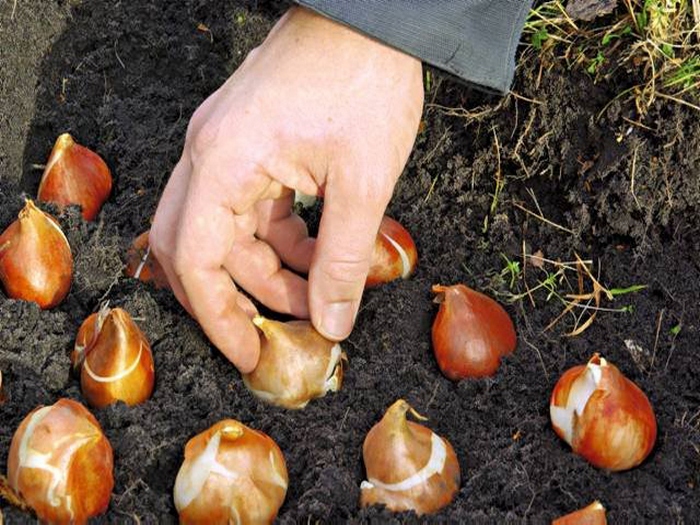
As for perennials, there are more reasons to sow in the fall. The fact is that many types of perennial ornamental plants are necessary for seed germination - that is, cold treatment. In order to grow these flowers in a seedling way, the soaked seeds are kept in the fridge for 2-3 months. However, it is much easier to sow these seeds in the ground before winter, and then the stratification will take place naturally without much effort on your part.
Most perennials develop much more successfully when it is underwintering. And if you cover the shoots with a film in the spring, you can often even achieve their flowering in the first year of life.
As to the germination of perennial seeds during autumn planting, it is significantly higher than that of annual plants.
Autumn sowing annuals
The first rule in the autumn planting of annual crops is to sow in the already frozen ground. Otherwise, the seeds can germinate prematurely and die at the first frost.However, it is necessary to start preparing the soil in advance - at the end of September - beginning of October, before the earth freezes. It is necessary to carefully plan the site for planting, so that in the spring the seeds are not washed away with melt water.
To prepare the soil in the selected area you need to dig, fertilize and make shallow grooves or holes. The depth of the grooves is calculated on the basis of selected plant species: for large seeds, a depth of about 4-5 centimeters is needed, for medium ones - about 2, for small ones - no more than 1 centimeter.
In addition, it is worth pre-stock the substrate for powdering the seeds. Since during the winter, the topsoil can become very compacted, making it difficult to germinate, it is recommended to sprinkle the crops with a thin layer of peat, humus or light soil mixture from compost, peat with sand or humus with sand.
The actual crops can be started in two terms: in November-December, when the topsoil is frozen, or over snow, in December-January. In any case, the seed is worth sowing thicker than in the spring.
When sowing in late autumn, the seeds are placed in the grooves and sprinkled with prepared soil mixture. From above, you can additionally cover crops with a layer of dead foliage.
For winter (in December-January, when the snow layer will be at least 25 centimeters), the soil is prepared in the same way (digging, fertilizing), but the ground grooves are not necessary, since the seeds are sown directly in the snow.
Snow trample down, make grooves in it, place seeds in them. From above, crops are sprinkled with a layer of prepared (unfrozen) soil mixture or peat and, in addition, with a layer of snow.
Spring shoots will need to be thinned.
Some of the annuals suitable for podzimnogo seeding: erythrophagous and rain dimorphotech, bitter and umbrella, collinsia raznosistny, twice perist and sulfur yellow, keeled, sown and topped, malcolmia coastal, 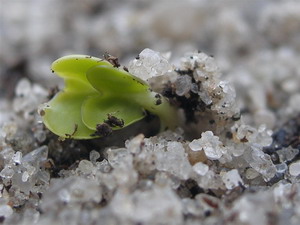 Drummond,.
Drummond,.
Autumn sowing perennials
The soil for the autumn sowing of perennial flowers is prepared as well as for the letniki: they dig, fertilize and make grooves. Sowing start from mid-October to early November. Seeds are also sprinkled with a thin layer of prepared soil mixture.In the spring, after the snow melts, it is advisable to cover the sowing bed with foil. Thus, you will accelerate the flowering of perennials, and at the same time save seeds from birds and spring rains. After the shoots appear, the film should be removed.
The intensive gardening season in central Russia ends in October, and for many gardeners, a period of forced idleness begins. However, the time freed up in the autumn can be successfully used for the subsequent refining of the garden plot, making the necessary groundwork for spring work. For example, in the fall, before the onset of sustained, morning frosts, many flower plants can be sown. Autumn planting suitable colors has the following advantages:
· Time is saved when carrying out intensive landing works in the spring;
· Flowers planted in autumn will start blooming much earlier in spring;
· Many bulbous flowers require stratification, so the winter lowering of the soil temperature will replace the artificial stratification with the natural one.
Dates of autumn sowing.
In most European regions of Russia, the best time for autumn planting of plants is considered to be the onset of sustained autumn cold weather, falling in the middle - end of October - beginning of November. Despite the presence of morning frost, when the upper soil layer freezes, the seeds can be sown until a steady snow cover falls. Of course, the frozen soil will somewhat complicate sowing, but during the day this problem disappears. In addition, many gardeners with experience of autumn sowing, in advance, on warm autumn days, form beds for sowing seeds and dig grooves. 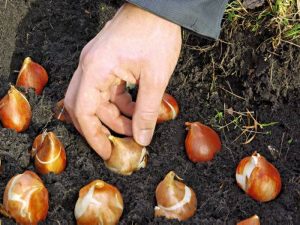 Features of autumn crops.
Features of autumn crops.
Autumn sowing means more frequent (thickened) and deep sowing of seed material. This requirement is caused by the inevitable extinction of some part of the seed during the winter period. In order for the upper soil layer, which is filled with seeds, in the winter is not too compacted, which will prevent the penetration of sprouts in the spring, the surface of the seed-planted areas mulch with a thin layer of humus or peat. Autumn watering of crops is not only unnecessary, but also undesirable, since suddenly warm days will provoke seed germination, and autumn crops may be ruined. In the spring for pre-winter crops also does not require intensive watering. The soil moisture accumulated during the melting of the snow cover will be quite enough for the development of plants. 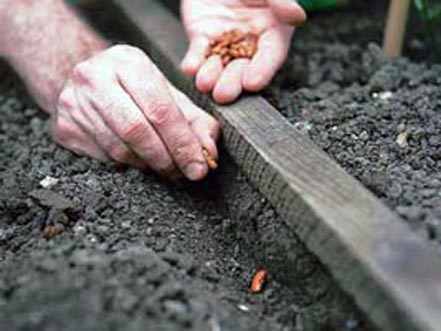 Autumn crops annual flower plants.
Autumn crops annual flower plants.
Best suited for autumn sowing annual flowers:
aster, iberia -purple, rezeda fragrant, clarky marigold, Collinsia, Ajax delphinium, Chinese carnation, adonisletny
and many others.
All these flowers should be sown in a permanent place of spring-summer-autumn bloom. Most of these flowers are critical to spring transplanting, which will negate all the benefits of pre-winter planting. If the winter was not frosty, and a dense planting formed in the spring, the plants should be thinned out. Beds with aster, at the onset of spring thaws, it is necessary to cover with plastic wrap. 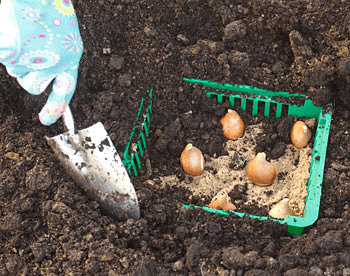 Autumn sowing of perennial plants.
Autumn sowing of perennial plants.
Seeding (planting) material of many perennial flowers requires stratification. When spring planting, it is performed by placing the planting material in the refrigerator. Autumn sowing by itself implies a natural stratification in winter frosts.
Stratification is required for such colors like lavender, tulips, delphinium, primrose, gentian, aquilegia, hellebore, doronicum, gaillardia, lychnis, lupine, bell peach and Carpathian, obriet, carnation, chamomile, arabis, yarrow, small giraffe, wind-resistant, yarrow, small-scale artist, wind-resistant, yarrow, small-scale artist, wind-resistant, yarrow, small-scale artist, wind-resistant, yarrow, small-scale artist, wind-resistant, yarrow, small-scale artist, wind-resistant, yarrow, small-scale artist, winter-resisting patterns, chorus, speed-keeping patterns, choromas, chorus, cramped, cramped, cramped, cramped, cramped, cramped, cramped, cramped, cramped, cramped, cramped, cramped, cramped, cramped, cramped, cramped, cramped, cramped, cramped, cramped, cramped, cramped, cramped, cramped, cramped, cramped, augured , buzulnik, euphorbia, churchyard, rudbeckia, geykhera,
and some other plants. 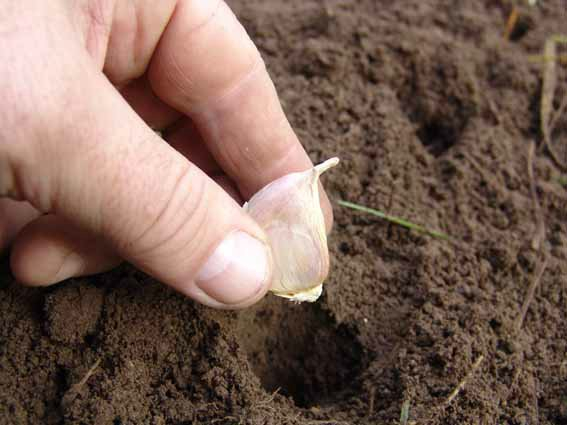 Autumn crops of vegetable crops.
Autumn crops of vegetable crops.
The seeds of a number of vegetable crops sown in autumn will allow the gardener to receive the next summer a crop of 1 ... 3 weeks earlier than during spring planting. For autumn sowing use:
dill, lettuce, parsley, celery, physalis, parsnip, spinach, sorrel, rhubarb, cilantro, radish, arugula, borage, salad mustard, color, red, Peking cabbage, carrots, black onions (seeds), beet seeds, tomato .
There are two kinds of garlic, spring and winter (arrowhead). Autumn planting cloves or air bulbs of winter garlic is not only desirable, but also obligatory.
The deadline for planting garlic is mid-September - October. In order for it to be rooted before autumn frost, a bed of garlic is covered with straw, dry grass or mulched with peat. If you wish, you can plant onions in the fall. This will provide an opportunity to get an earlier harvest in the next season. At the same time, planting of onions is recessed, which will prevent their winter freezing.
Video Podzimny planting flowers and greenery.
Someone may object: "What can be grown in the fall?". You can grow and plant, it all depends on the goal that you set for yourself. This issue should be dealt with in more detail, since there is a difference between just planting in the fall and growing in the fall, moreover, both of these concepts fit the phrase "autumn crops".
We will deal with the first - growing. There are crops with a short growing season, that is, these are crops whose maturation lasts 20 to 30 days. These are mainly green crops and root vegetables, namely, lettuce, spinach, dill, onions on feathers, watercress, Peking cabbage (sometimes it has time to ripen in the middle latitudes of Russia, but here, you need to pick extra early varieties), radishes, radishes, turnips - as well as Peking cabbage, with a selection of appropriate varieties. Such crops are cold-resistant, and they feel the need for a temperature of 15-20 degrees, therefore, not always our summer plantings of such crops as radishes, radish, turnips, cabbage are crowned with success, and here fall plantings come to the rescue. After the summer heat, you will enjoy juicy, fragrant and crunchy root vegetables. You will not notice that on the table, besides everything, there are tomatoes and peppers, it will just be pleasant for you to eat these products. All these cultures can be grown in the autumn period, but following the basic rules of agricultural engineering.
The first and most important thing is to plant immediately after harvesting the main crops, since the dates are very tight, you cannot lose a day. The second is the soil conditions, it should be loose, waterproof and breathable. It is advisable to plant the plants on the southern slope or in areas protected from the north winds. So you shorten the period of growth and development of vegetable crops. Before planting, the soil should be well fertilized, nitrogen fertilizers can and should be added. Form rollers, between which you will have plants, width between rollers 35 - 45 cm. Special attention should be paid to additional covering materials. Already at the beginning of September night frost is highly probable. And since, at the same radish, the leaves turn black at minus 3-5 degrees, we need to think about how we can cover it. This can be anything from plastic films and window frames to rags and newspapers that you will put directly on the rollers. But despite everything, my advice to you, use a spunbond - a white material similar to cloth, but it lets through both light, and water, and air, unlike film. There is no need to remove the film before watering, and the threat of overheating. From the fact that the weight of the spanbond is so small, it can be "thrown" directly on the plants.
Now let's talk about autumn plantings. To get a harvest in early summer or even in spring, planting is done in autumn, they are often called winter crops. Since in the spring every minute is expensive, and we do not always have time to thrust the seed into the ground, autumn crops come to the rescue. It may be planted carrots, garlic, onions on the feather, spinach, rhubarb, sorrel, parsley, dill and other crops.
To get onions on a feather in early spring, they plant onions 10 to 15 days before cooling, so that he can take root and not too dissolve his “feathers”. The turnip is planted half-bridge, it is possible and the bridge method. This is when the bulbs are planted one near the other, without any distance between them. Thus, a row can be any width, but considering that you have to water and tear it, make a row about a meter wide, and 30 - 40 cm between rows. The bulbs are planted a little in the soil, and then sprinkled lightly with earth.
Garlic is planted in mid or late September. The soil is prepared for it in the fall, garlic is very responsive to pre-sowing soil treatment. They are planted in a wide-row fashion with 45 cm row spacing, and in a row the distance between rows is 5-8 cm from each other. The depth of embedment is 6–8 cm. It is advisable to cover the garlic with hay, straw, and corn stalks after autumn planting.
All other crops have similar requirements, the main thing is that their seeds do not have time to germinate in the fall, so you should plant them just before the frost. Of course, you need to pick the appropriate varieties. Heavy, humus-poor, acidic soils are not suitable for such crops. Covering such crops with straw, hay, other materials, make sure that there are no nests of mice, rats or other small pests under them, so their surface holes will not allow to see the planned harvest or the planting material that you used in the fall next year. Elementary you can decompose the mousetrap or poison bait.
Thus, using the autumn planting, you prolong the period of consumption of fresh, hand-grown vegetables. As you see, you will not need much effort, but you can get an additional crop of vegetables in the first case, or save time and get early, more friendly shoots in spring. Both options are a good help for the modern summer resident, who has every minute and every step of the land counts.
Autumn is the period when gardeners finish gardening work. When the onset of cold weather is recommended to start planting. When the topsoil begins to freeze, sowing is worth doing. The best period is considered the beginning of November. Experienced gardeners begin to prepare the soil from the end of September. At the same time, they dig up the soil and add various fertilizers.
The beginning of winter is also suitable for the procedure. December or January are considered the best period. Prerequisite is the presence of snow for this period (about 25 cm). Only seeds of annual plants are suitable, as they are more resistant to winter cold.
In order to successfully complete the procedure, gardeners should adhere to the basic recommendations:
- prepare the land with fertilizer before the procedure;
- seeding carried out in frozen soil;
- pre-select a place with good lighting.
Late autumn, seeds are sown on a prepared plot of land and covered with dry leaves or a mixture of sand and peat. In winter, snow is trampled on the site, and grooves are covered with a mixture of compost.
Ways to accelerate flowering
Sub-winter seeding not only hardens the plants, but also significantly accelerates flowering by 2–3 weeks. To speed up the flowering process, gardeners install metal arcs over the ridge. With the arrival of spring, when the snow has completely melted, cover the ridge with film material. With this technology, flowering plants will begin earlier than at least a week.
Autumn crops annuals
For podzimnogo sowing choose those annuals that are resistant and resistant to cold. Performing such a procedure in the winter creates the most comfortable conditions for development.
There are three options where you can sow the seeds of annual plants: capacity, school and flower garden. For each option there is a separate technology.
The process of planting annual plants in a school or flower garden is accompanied by certain measured actions that gardeners need to be aware of:
- Shkolku place on a high site. It is necessary to choose the location of the school in view of protection from cold winds. The height must be at least 20 cm.
- Plot a flower bed in advance to dig and fertilize, which contain phosphorus.
- After compaction of the soil, mark out special nests.
- Determine the seeding depth. Depth is determined according to the size of the seed (from 0.5–4 cm).
- Place dried seeds in pre-prepared nests. Each department holds 3 large seeds or up to 10 small ones.
- Fill the sowing with a special mixture. Gardeners use a mixture of humus to fill the soil. You can also use peat with sand.
- Soil mulching. Carry out the procedure using leaf drops and clean up after the snow melts in spring.
According to the technology, it is worth thinning the shoots three times: on the first leaflets, then after two weeks. Gardeners leave one or two plants in each nest. The third thinning is done with nesting sowing.
Gardeners use for sowing:

- not very deep tanks (up to 10 cm) with drainage holes;
- nutrient substrate;
- a mixture of peat, sand and garden soil (3: 3: 1).
The bottom of the tank is filled with a two-centimeter layer of drainage. Then proceed to compacting the soil special mixture, the thickness of which should not exceed 6 cm.
Leave a part of the substrate for backfilling. Put containers into prepared pits (trenches). It is worth remembering that the height of the pit should be greater than the height of the tank by 15–20 cm. The difference is filled with drainage. Cover with foil.
Before sowing, gardeners remove the film, and flower seeds are spread on top of the ground. The soil is filled with a special soil mixture, pre-prepared.
In the spring, mulching is carried out using leaf litters. Toward the end of May, the flowers are transplanted.
For winter sowing, these types of annuals are suitable:
- . Annual, reaching a height of up to 100 m. Grown in groups. Thinning seedlings carried out at a distance of 30 m.
- . The annual flower is 40 cm high. The seeds of resedy are sown in rows at a distance of 50 cm.
- . Genus of annual herbaceous plant. It grows in sod-sandy soil with moderate humidity.
- . It belongs to the family of asters 60 cm high. For planting it is recommended to choose a place with good lighting and dry soil.
Gardeners choose annual plants because of the good tolerance of winter cold. Flowers have a short growing season (about 60 days) and are unpretentious to either sunlight or other conditions.



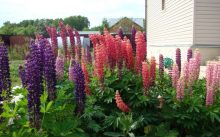
Autumn crops of perennials
For podzimnogo seeding prefer to choose perennial flowers, as they are easily adapted to low temperatures. The choice of perennial is based on the choice of that seed, having a dense shell with essential oils. The color grower, before direct sowing, must perform well-known procedures:
- Selection of seed places in advance. The place should be well lit, not on a hill or low.
- Drainage. At the bottom of the pit pour a small layer of crushed stone up to 2 cm thick. Remove a little of the ground that will be needed to prepare the mixture.
- Tillage. Florists dig up the area, then apply organic fertilizer with the addition of potassium or phosphorus.
- Pass the period of stratification. Three months before sowing, the seeds are kept in a small cold sand tank. Florists store them in refrigerators.
Seeds of perennials spread in separately made wells up to 4 cm deep, then sprinkled with soil. For powder using loose soil.
During the frost period, flower growers prefer to warm areas with straw or old leaves. For the enrichment of the seed of perennial flowers, with the arrival of spring, a covering ground is used. After the spring temperature has normalized, the seedlings are thinned and then transplanted.
For podzimnyh crops suitable seeds of various perennials. Among them are:
- Perennial flower up to 30 cm high. Flowering plants can last about 4 weeks of the spring period.
- Perennial herbaceous flower with single flowers with a diameter of up to 20 cm. It blooms until mid-June. Prefers a loose soil plot.
- There are about 30 different varieties. Prefers dry soil with drainage.
- Carnation Turkish. Herb garden plant that is not capricious in the care. Duration of flowering about a month.
Perennials sown in winter are more frost resistant and are protected from diseases. Plants are hardened, in spring they give strong shoots.
 Turkish carnation
Turkish carnation 


Autumn crops of garden crops
Planting of garden crops is carried out throughout the autumn. The sowing period is selected according to the type of garden crop. Until the end of October, gardeners sow garlic or onions, in the early days of November they plant carrots, parsley or radishes.
Three weeks before the procedure, gardeners begin preparing the soil. Up to 4 kg of humus and a glass of wood ash are introduced, thus fertilizing the soil. Fertilizers dig up to a depth of 20 cm and form a bed of the desired length.
For each type of garden culture there are different rules:
- The depth of planting is up to 6 cm. The distance between the bulbs is 8 cm. When planting in winter, the neck of the bulbs is not cut to prevent rotting. When nesting planting put on 3 bulbs in the nest.
- The depth of landing of the bulbhobes is no more than 3 cm, the distance is 15 cm between the lines.
- Planted to a depth of 3 cm. Be sure to moisten, and after promulgate crops. The mulch layer should not exceed 4 cm.
- Green cultures are planted at a distance of 8-10 cm between rows. In the spring cover film material.
Subwinter crops not only of flowers, but also of various root crops significantly save the time of spring work, since they do not require careful maintenance. Gardeners, gardeners, adhering to the recommendations, will be able to get a quality crop from planted flower and garden materials.



